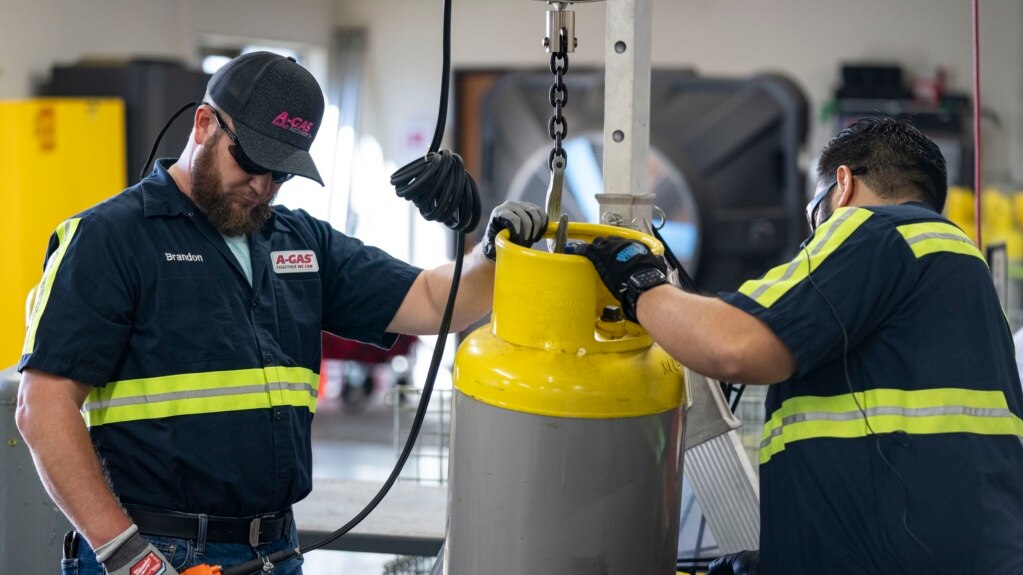Jennifer Byrne owns a heating and air conditioning repair company in the American city of Philadelphia, Pennsylvania.
Air conditioning, or AC equipment, cools the air in a home. To do this, the equipment uses a gas called a refrigerant.
While working on AC equipment in a house, Byrne puts gas from the equipment into a special container.
The gas is known by an industrial name: R-410A. Scientists say it traps 2,088 times more heat in the atmosphere than carbon dioxide.
Because chemical refrigerants capture heat, some people say they need to be replaced with something else. Some scientists are worried that the release of methane, carbon dioxide, and other gases is making the atmosphere warmer.
The Clean Air Act bars businesses from releasing refrigerants into the air on purpose. Some companies are trying to find replacement gases that trap less heat, which might work almost as well.
Leaking AC equipment in homes is one way the gases get into the atmosphere. Cars are another source of these pollutants, said Eckhard Groll. He is an expert in refrigeration and head of mechanical engineering at Purdue University in the state of Indiana.
He said AC units in cars can leak. He said that, on average, about 25 percent of refrigerant from all cars leak out every year. There are more than 200 million gasoline cars in the U.S. alone, Groll said. Using those numbers, Groll said he estimates about 45 million kilograms of refrigerant is leaking into the atmosphere each year.
Supermarkets are the second-largest source of leaks. Long pipes carry refrigerant to coolers that store food. Danielle Wright is head of the North American Sustainable Refrigeration Council, a nonprofit group based in Mill Valley, California. It supports cleaner methods of cooling.
Wright said the average supermarket leaks about 25 percent of its refrigerant each year. That number is based on a U.S. Environmental Protection Agency report from 2005.
She criticized supermarkets, saying “…it’s cheaper to leak the refrigerant than to build a leak-proof system.”
Limiting leaks is important because the refrigerant can be reused. Many businesses recycle refrigerant gas. One such company, A-Gas, was founded in Britain in 1993. The company has several centers in the U.S.
Refrigerants can be used many times over and can last for 30 years, said Mike Armstrong, President of A-Gas in the Americas. The company takes in refrigerants and containers from around the U.S. and other countries. It processes the gas to be sold and used again. He said his business is doing well.
“This industry is probably going to increase four to five times in the next couple years,” Armstrong said.
The chemical industry is also looking for a chemical to replace R-410A. Some researchers have suggested carbon dioxide itself as a possibility. But Groll of Purdue University said that carbon dioxide has to be under high pressure to work as a refrigerant. Completely different equipment would be necessary.
Christopher Cappa teaches environmental engineering at the University of California, Davis. He said carbon dioxide would be useful “if we’re pulling it out of the atmosphere.” But he added, “if we’re producing it just as a refrigerant, that wouldn’t be necessarily nearly as good.”
Refrigeration easier to clean than air conditioning
Wright of the Sustainable Refrigeration Council supports the use of carbon dioxide. “This is kind of a low-hanging fruit, it’s a known technology and it’s market ready,” she said.
However, she said that reducing leaks from air conditioners is more difficult. She said chemical and equipment manufacturers and existing building rules have slowed the growth of new refrigerants in the U.S.
But one manufacturer, Trane Technologies, said it has been working hard on different choices. Trane says it has a refrigerant that is 78 percent less damaging to the environment than the current one. The company says it will start using it in its equipment beginning in 2024.
And at Harvard University, researchers are working to develop a solid refrigerant instead of a gas. Jarad Mason, an assistant professor of chemistry and chemical biology at Harvard University, is working on the project.
He said he is hopeful about using solid materials because they could be used in both large buildings and normal homes.
“Demands for heating and cooling are only going to increase,” he said. He added that researchers must find ways of cooling that do not harm the environment and are not costly.
I’m Andrew Smith. And I'm Jill Robbins.

